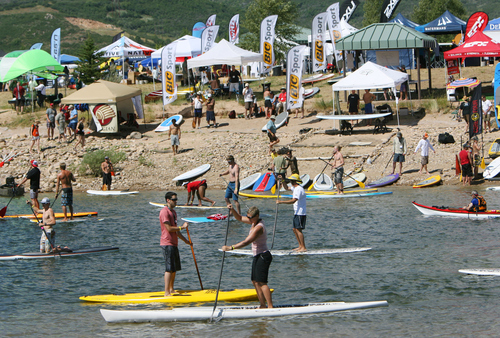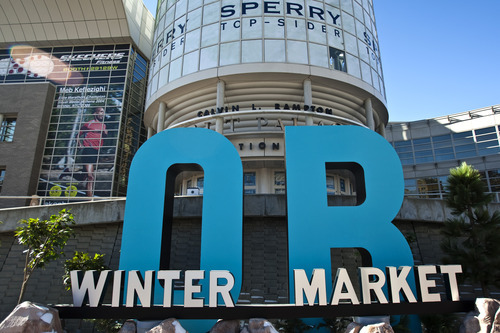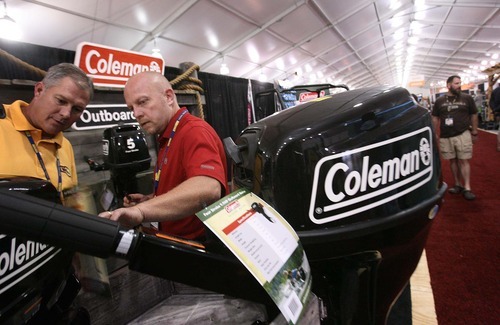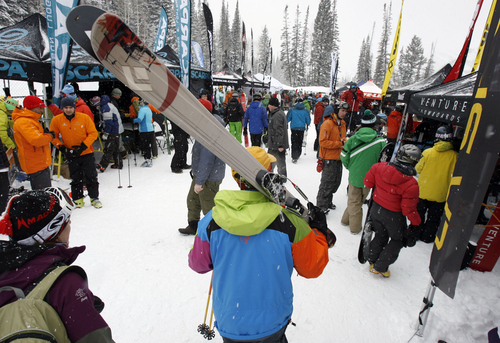This is an archived article that was published on sltrib.com in 2012, and information in the article may be outdated. It is provided only for personal research purposes and may not be reprinted.
One of Utah's largest conventions may go elsewhere when the Outdoor Retailer's contract to stage summer and winter trade shows at the Calvin L. Rampton Salt Palace Convention Center expires at the end of 2014 because the events are outgrowing the venue.
In January, a record 21,000 visitors filled hotels and restaurants to near capacity, and the Outdoor Retailer Summer Market draws thousands more participants — generating nearly $40 million in direct economic impact to Salt Lake City and the state annually.
"Salt Lake City has gone to great lengths to accommodate us, but the show is continuing to face challenges that are reflected in the fact that we must build outside structures to accommodate all our participants," said Outdoor Retailer spokeswoman Maura Lansford. "As people think about our future, we want them to understand that every city has advantages, as well has some hassles and challenges, that we'll have to face."
Other locations under consideration are Denver, Las Vegas, Anaheim, Calif., and Orlando, Fla.
The not-open-to-the-public shows, which attract 7,100 retail attendees, connects buyers from outdoor specialty stores with more than 1,100 brands from around the world.
Outdoor Retailer and its sponsor, the Outdoor Industry Association, have launched a website to discuss possible locations of future shows. Survey forms, to be provided in May, are open to members and stakeholders who have exhibited or sponsored an event or partnership with the shows within the past three years.
The groups list advantages for staying in Salt Lake City, which include nearby recreational sites for participants and a relationship with the community that dates to 1996. But that must be weighed against insufficient hotel rooms and convention space, forcing some participants to book rooms 45 miles south in Provo and others to stage events in tents, they said.
Using other exhibit space in the Salt Lake Valley has been discussed, but that option would require dividing the shows and requiring some attending to visit facilities 15 miles apart, and forcing exhibitors to set up booths in separate locations.
The groups contend that the Salt Palace is suitable only if growth is curtailed or the city, county and state agree to significantly expand the convention center, as well as add hotel rooms and other needed transportation infrastructures.
Jason Mathis, executive director of the Downtown Alliance, said Salt Lake City offers intangibles to show participants, including a longtime relationship and welcoming atmosphere. He believes the groups are testing the waters to see what the community will look like in five years, "and whether we will embrace the convention industry and make the investments to be a more competitive destination."
Previous concerns about space several years ago helped prompt an expansion of the Salt Palace.
"Expansion of the Salt Palace is not likely [this time], but several private entities are looking at developing a convention hotel," he said. "Right now, public entities are trying to figure out what if any role the public sector should play in making a convention hotel a reality."
Salt Lake County officials have considered partnering with a private developer to build a 1,000-plus-room hotel — bigger than any other in Utah — in the heart of the capital's convention district. The facility would include a large block of rooms for big conventions, as well as adding 80,000 to 100,000 square feet of additional conference space. A formal plan that could be voted on by an elected body has yet to materialize.
Convention centers in the four other cities under consideration are larger than the Salt Palace, which has 510,600 square feet of space that the groups describe as "somewhat fragmented," rather than a more accommodating contiguous area. Although Las Vegas has three larger and perhaps more suitable convention centers, the summer show would open during one of the hottest months of the year. The groups say the weather also is a drawback in Florida, where August is "a miserably hot and humid time."
On the other hand, airports in Orlando and Southern California can better accommodate international flights, and both locations have numerous hotels and restaurants.
Said show manager Kenji Haroutunian: "There are a lot of good reasons why we want to stay in Salt Lake City. It's been a great run. We're double or bigger the size than when we came 16 years ago and during the time, the city has grown, too. What's broke is trying to fit in the new people who want to be in the show, who are not part of the old guard. We're not excited to move out of Salt Lake City, but we'll be listening to what they have to say."
dawn@sltrib.comTwitter: @DawnHouseTrib —
Outdoor Retailer winter, summer shows
Events • Staged at the Salt Palace convention center, attracting 21,000 visitors during winter show and 25,000 for the summer show.
Purpose • Connects buyers from outdoor specialty stores with more than 900 manufacturers worldwide.
Revenue • Each show generates nearly $20 million for the Salt Lake City and state economies.
Survey • Stakeholders' responses will help determine location of future shows, at http://www.outdoorretailer.com/collective-voice.











